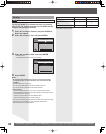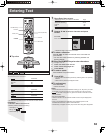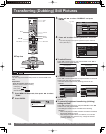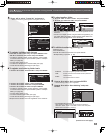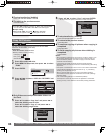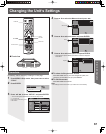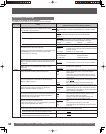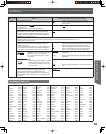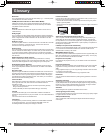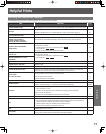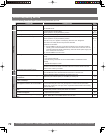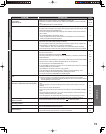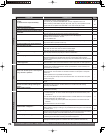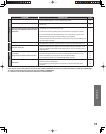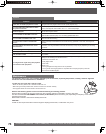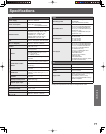
70
For assistance, please call : 1-800-211-PANA(7262) or, contact us via the web at:http://www.panasonic.com/contactinfo
Bitstream
This is the digital form of multi-channel audio data (e.g., 5.1 channel) before
it is decoded into its various channels.
CPRM (Content Protection for Recordable Media)
CPRM is technology used to protect broadcasts that are allowed to be
recorded only once. Such broadcasts can be recorded only with CPRM
compatible recorders and discs.
Decoder
A decoder restores the coded audio signals on DVDs to normal. This is
called decoding.
Dolby Digital
This is a method of coding digital signals developed by Dolby Laboratories.
Apart from stereo (2-channel) audio, these signals can also be multichannel
audio. A large amount of audio information can be recorded on one disc
using this method.
Dolby Pro Logic
A surround system where a 4-channel audio track is recorded as 2 channels
and then is restored to 4 channels for play. The surround channel is
monaural and can reproduce up to 7 kHz.
Down-mixing
This is the process of remixing the multi-channel audio found on some discs
into two channels for stereo output. It is useful when you want to listen to the
5.1-channel audio recorded on DVDs through your television’s speakers.
Some discs prohibit down-mixing and this unit can then only output the front
two channels.
DPOF (Digital Print Order Format)
DPOF is the standard printing format for still picture data. It is used by
photo developing stores to print out the still picture data taken from a digital
camera and other equipment or when printing from your home printer.
DTS (Digital Theater Systems)
This surround system is used in many movie theaters around the world.
There is good separation between the channels, so realistic sound effects
are possible.
Dynamic range
Dynamic range is the difference between the lowest level of sound that can
be heard above the noise of the equipment and the highest level of sound
before distortion occurs. Dynamic range compression means reducing the
gap between the loudest and softest sounds. This means you can listen at
low volumes but still hear dialog clearly.
Film and video
DVD-Videos are recorded using either film or video. This unit can determine
which type has been used, then uses the most suitable method of
progressive output.
• Film is 24 or 30 frames per second, with motion picture film generally
being 24 frames per second.
• Video is 60 fields per second (two fields making up one frame).
Finalize
A process that makes play of a recorded CD-R, CD-RW or DVD-R etc.
possible on equipment that can play such media. You can finalize DVD-R on
this unit.
You cannot record onto or edit finalized discs.
Formatting
Formatting is the process of making media such as DVD-RAM recordable
on recording equipment. You can format the DVD-RAM on this unit.
Formatting erases irrevocably all recordings on the disc.
Frames and fields
Frames refer to the single images that constitute the video you see on your
television. Each frame consists of two fields.
• A frame still shows two fields, so there may be some blurring, but picture
quality is generally better.
• A field still shows less picture information so it may be rougher, but there is
no blurring.
JPEG (Joint Photographic Experts Group)
This is a system used for compressing/decoding color still pictures. If you
select JPEG as the storage system on digital cameras etc., the data will
be compressed to 1/10–1/100 of its original size. The special quality of this
standard is that there is little deterioration in picture quality in comparison to
the degree of compression.
LPCM (Linear pulse code modulation)
These are uncompressed digital signals. This unit outputs linear PCM sound
in 2 channels from the DIGITAL AUDIO OUT terminal. LPCM sound is
available when recording in XP mode.
MP3 (MPEG Audio Layer 3)
An audio compression method that compresses audio to approximately one
tenth of its size without any considerable loss of audio quality. You can play
MP3 you have recorded onto CD-R and CD-RW.
Playback control (PBC)
If a Video CD has playback control, you can select scenes and information
with menus.
Progressive/Interlace
NTSC, the video signal standard, has 480 interlaced (I) scan lines, whereas
progressive scanning uses twice the number of scan lines. This is called
480P.
Using progressive output, you can enjoy the high-resolution video recorded
on media such as DVD-Video.
Your television must be compatible to enjoy progressive video.
Protection
You can prevent accidental erasure by setting writing protection or erasure
protection.
Sampling frequency
Sampling is the process of converting the heights of sound wave (analog
signal) samples taken at set periods into digits (digital encoding). Sampling
frequency is the number of samples taken per second, so larger numbers
mean more faithful reproduction of the original sound.
Subtitles
When dialogue which appears at the bottom of the screen.
TIFF (Tag Image File Format)
A still picture data standard A common format for storing high quality images
on digital camera’s and other devices.
VBR (Variable bitrate)
This is a method of video recording that adjusts the bit rate according to
video signal.
Glossary
=
+
Frame Field Field



